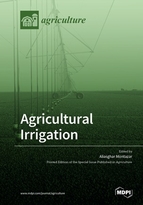Agricultural Irrigation
A special issue of Agriculture (ISSN 2077-0472).
Deadline for manuscript submissions: closed (20 May 2019) | Viewed by 50367
Special Issue Editor
Interests: agricultural water management; drainage and water quality; on-farm water conservation; salinity management and control practices; environmental instrumentation and modeling
Special Issues, Collections and Topics in MDPI journals
Special Issue Information
Dear Colleagues,
Agriculture is certainly the most important food supplier while it globally accounts for more than 70% of water used and contributes significantly to water pollution. Irrigated agriculture is facing rising competition worldwide for access to reliable, low cost, and high-quality water resources. However, irrigation as the major tool and determinant of affecting agricultural productivity and environmental resources plays a critical role in food security and environment sustainability. Innovative irrigation technologies and practices may enhance agricultural water efficiency and production, in the meantime decrease the water demand and quality issues. I am very pleased to invite you to submit manuscripts in agricultural irrigation which assess current challenges and offer improvement approaches and opportunities for future irrigation.
Dr. Aliasghar Montazar
Guest Editor
Manuscript Submission Information
Manuscripts should be submitted online at www.mdpi.com by registering and logging in to this website. Once you are registered, click here to go to the submission form. Manuscripts can be submitted until the deadline. All submissions that pass pre-check are peer-reviewed. Accepted papers will be published continuously in the journal (as soon as accepted) and will be listed together on the special issue website. Research articles, review articles as well as short communications are invited. For planned papers, a title and short abstract (about 100 words) can be sent to the Editorial Office for announcement on this website.
Submitted manuscripts should not have been published previously, nor be under consideration for publication elsewhere (except conference proceedings papers). All manuscripts are thoroughly refereed through a single-blind peer-review process. A guide for authors and other relevant information for submission of manuscripts is available on the Instructions for Authors page. Agriculture is an international peer-reviewed open access monthly journal published by MDPI.
Please visit the Instructions for Authors page before submitting a manuscript. The Article Processing Charge (APC) for publication in this open access journal is 2600 CHF (Swiss Francs). Submitted papers should be well formatted and use good English. Authors may use MDPI's English editing service prior to publication or during author revisions.
Keywords
- Agricultural Irrigation
- Agricultural Irrigation Tools and Technologies
- Agricultural Water Management
- Agricultural Water Quality
- Agricultural Water Use Efficiency






